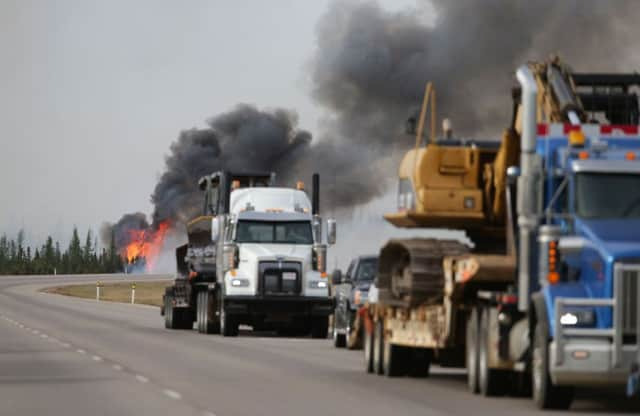Massive blaze in Alberta '˜may burn for months'


There is fear the growing wildfire could double in size and reach a major oil sands mine – and possibly cross into the neighbouring province of Saskatchewan.
The Alberta government said the massive blaze will cover more than 494,211 acres and continues to grow because of high temperatures, dry conditions and high winds. Chad Morrison of Alberta Wildfire said it was not uncommon to fight such an inferno in forested areas for months.
Advertisement
Hide AdAdvertisement
Hide AdMr Morrison said the fire was burning away from communities this weekend. He expected cooler temperatures, but said significant rainfall is needed. Environment Canada forecasted a 70 per cent chance of showers last night.
Officials had hoped to complete the mass evacuation of work camps north of Fort McMurray on Saturday. Thousands of displaced residents got a drive-by view of some of the burned-out neighbourhoods as convoys continued. No deaths or injuries have been reported since the fire started last Sunday.
Alberta premier Rachel Notley said about 12,000 people have been airlifted from oil sands mine air fields over the past two days, and about 7,000 have left in highway convoys escorted by police.
The fire could reach the edges of the Suncor oil sands facility, about 15 miles north of Fort McMurray. Non-essential staff have been leaving and efforts to protect the site were underway.
Ms Notley said that the facility was highly resilient to forest fires. Oil sands mines are cleared and have no nearby vegetation. Mr Morrison said the fire was not expected to reach the oil sands mines north of Suncor.
The fire and mass evacuation has forced a quarter or more of Canada’s oil output offline and was expected to have a huge impact on an economy already hurt by the fall in the price of oil. The Alberta oil sands have the third-largest reserves in the world behind Saudi Arabia and Venezuela. Its workers largely live in Fort McMurray.
Police said many parts of the town are burnt out and visibility is low due to thick smoke. Officers wore masks as they checked homes to make sure everyone was out.
More than 80,000 people have left Fort McMurray, in the heart of Canada’ oil sands, where the fire has destroyed 1,600 homes and other buildings. Gas has been turned off, the power grid is damaged and water is not drinkable.
Advertisement
Hide AdAdvertisement
Hide AdOfficials said there is no timeline to return residents to the city, but the Alberta government has begun preliminary planning, though it stresses fighting the fire is still the first priority.
About 25,000 evacuees moved north in the hours after Tuesday’s mandatory evacuation, where oil sands work camps that usually house employees were used to house those fleeing the town. Officials are now moving everyone south where it is safer.
Syncrude, a major oil sands mining company, also shut down operations and evacuated. The company said in a statement that while there is no imminent threat from fire, smoke has reached its Mildred Lake site.
The fire started last Sunday and has destroyed about than 772 square miles of northern Alberta forest.